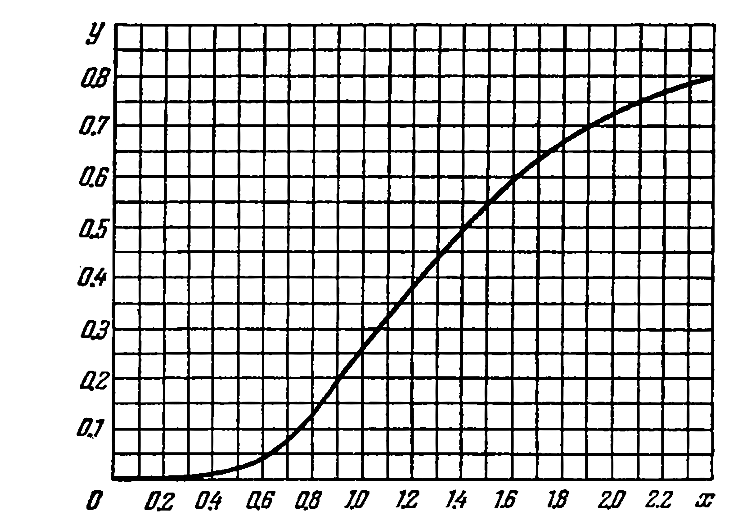Fig. shows the plot of the function y(x) representing a fraction of the total power of thermal radiation falling within the spectral interval from 0 to x. Here x=λ/λm(λm is the wavelength corresponding to the maximum of spectral radiation density).
Using this plot, find:
(a) the wavelength which divides the radiation spectrum into two equal (in terms of energy) parts at the temperature 3700K,
(b) the fraction of the total radiation power falling within the visible range of the spectrum (0.40−0.76μm) at the temperature 5000K,
(c) how manu times the power radiated at wavelengths exceeding 0.76μm will increase if the temperature rises form 3000 to 5000K.

(a) From the curve of the function y(x) we see that y=0.5 when x=1.41
Thus λ=1.41×0.293700cm=1.105μm
(b) At 5000K
λ=0.295×10−6m=0.58μm
So the visible range (0.40 to 0.70)μm corresponds to a range (0.69 to 1.31) of x. From the curve
y(0.69)=0.07
y(1.31)=0.44
so the fraction is 0.37
(c ) The value of x corresponding to 0.76 are
x1=0.76/0.290.3=0.786 at 3000K
x2=0.76/0.290.5=1.31 at 5000K
The requisite fraction is then
(P2P1)=(T2T1)4↑ratio of t otal power×1−y21−y1↑ratio of the fra ction of required wavel eng ths i n the radiated power
=(53)4×1−0.441−0.12=4.91
Related Playlists
- BOOK - IE IRODOV, LA SENA & SS KROTOVCHAPTER - OPTICSEXERCISE - Exercise2videos
OPTICS
- BOOK - IE IRODOV, LA SENA & SS KROTOVCHAPTER - OPTICSEXERCISE - Optics Of Moving Sources22videos
OPTICS
- BOOK - IE IRODOV, LA SENA & SS KROTOVCHAPTER - MECHANICSEXERCISE - Mechanics Problems92videos
MECHANICS
- BOOK - IE IRODOV, LA SENA & SS KROTOVCHAPTER - OSCILLATIONS AND WAVESEXERCISE - Electromagnetic Waves, Radiation36videos
OSCILLATIONS AND WAVES
Similar Questions
λm is the wavelength of the radiations corresponding to maximum intensity of a very very hot body at temperature T. Which of the following correctly represents the relations between λm and T:
View SolutionUsing Planck's formula, find the power radiated by a unit area of a black body within a narrow wavelength interval Δλ=1.0nm close to the maximum of spectral radiation density at a temperature T=3000K of the body.
View Solutionif λv',λx and λm represent the wavelengths of visible light X-rays and microwaves respectively then:
View SolutionThe thermal emissivitites of two bodies A and B are in the ratio of 1/e. The outer surface area of the bodies are same and they radiate the energy at the same rate. Find the ratio of the wavelength corresponding to the maximum spherical radiance in the radiation from A to maximum spectral radiance in the radiation from B.
View Solutionif λv',λx and λm represent the wavelengths of visible light X-rays and microwaves respectively then:
View SolutionTwo bodies A and B ahave thermal emissivities of 0.01 and 0.81 respectively. The outer surface areas of the two bodies are the same. The two bodies emit total radiant power of the same rate. The wavelength λB corresponding to maximum spectral radiancy in the radiation from B shifted from the wavelength corresponding to maximum spectral radiancy in the radiation from A, by 1.00μm. If the temperature of A is 5820K:
View SolutionTwo black bodies A and B at temperatures 5802 K and 1934 K emits total radiations at the same rate. The wavelength λB corresponding to maximum spectral radiancy from B is shifted from the wavelength corresponding to maximum spectral radiancy in the radiation from A by 1.00μm. Then
View SolutionFor an enclosure maintained at 2000K, the maximum radiation occurs at wavelength λm. If the temperature is raised to 3000K, the peak will shift to
View SolutionFor an enclosure maintained at 2000K, the maximum radiation occurs at wavelength λm. If the temperature is raised to 3000K, the peak will shift to
View SolutionThe wavelength corresponding to maximum spectral radiancy of a black body A is lambda_(A) =5000A .Consider another black body B whose surface area is twice that of A and total radiant energy by B is 16 times that emitted by A .The wavelength corresponding to maximum spectrum radiancy for B will be
View Solution

